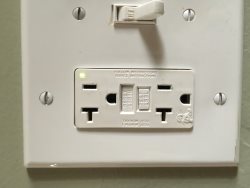| | Published May 26th, 2021
| The shocking truth about GFCI outlets
| | | By Jim Hurley |  | | |
In the third season of "Goliath" (a somewhat noir series, but worth watching if you haven't), Diana and Wade Blackwood, portrayed by Amy Brenneman and Dennis Quaid, play an intense game where one of them sits in the bathtub full of water and the other throws in a toaster. Apparently, the thrill is in not knowing if the toaster is plugged in when it hits the water. Of course, I have a little trouble suspending disbelief because I know that building codes require GFCI outlets in any bathroom, kitchen, and outdoor area where water may be accessible. The submerged toaster would trip the GFCI outlet in the blink of an eye, cutting off power to the outlet, and no one gets electrocuted.
 The Ground Fault Circuit Interrupter (GFCI) outlet is designed to save lives by preventing electrical shock. The GFCI device monitors the current passing through the outlet and automatically shuts off, when it detects an unrestricted flow.
The Ground Fault Circuit Interrupter (GFCI) outlet is designed to save lives by preventing electrical shock. The GFCI device monitors the current passing through the outlet and automatically shuts off, when it detects an unrestricted flow.
 By GFCI Device, I mean that odd outlet you see in homes with the buttons that say "TEST" and "RESET." A GFCI outlet can also be installed to protect additional outlets connected in series further down the wire. But wait, there's more! A GFCI Circuit Breaker could be installed in your electrical panel to protect every outlet on that circuit.
By GFCI Device, I mean that odd outlet you see in homes with the buttons that say "TEST" and "RESET." A GFCI outlet can also be installed to protect additional outlets connected in series further down the wire. But wait, there's more! A GFCI Circuit Breaker could be installed in your electrical panel to protect every outlet on that circuit.
 Hard to believe? Here is how it works: Your house outlets are wired as sets of circuits. Each circuit is attached to a breaker in your electrical panel. The wire goes through the wall to the first outlet in the circuit and on to the next like a daisy chain. By installing a GFCI breaker in the panel, all the outlets are under the super sensitive protection of that breaker. If one outlet pops the breaker, all the other outlets are shut off until you reset the breaker. This is great protection from shocks, but the downside is a trip to the electrical panel if it pops.
Hard to believe? Here is how it works: Your house outlets are wired as sets of circuits. Each circuit is attached to a breaker in your electrical panel. The wire goes through the wall to the first outlet in the circuit and on to the next like a daisy chain. By installing a GFCI breaker in the panel, all the outlets are under the super sensitive protection of that breaker. If one outlet pops the breaker, all the other outlets are shut off until you reset the breaker. This is great protection from shocks, but the downside is a trip to the electrical panel if it pops.
 Some people install a GFCI outlet at every receptacle near water, but one outlet can actually protect other outlets on the same circuit. The outlet has two sets of screws for connecting wires, one is marked Line, where the power comes in, and the other is Load, where the wire and power continue to the next outlet. If additional outlets are added on the Line side of the GFCI outlet, the outlet will pop when any of those outlets sense an overload. In this case, you need to find the GFCI outlet that triggered to reset the rest of the outlets.
Some people install a GFCI outlet at every receptacle near water, but one outlet can actually protect other outlets on the same circuit. The outlet has two sets of screws for connecting wires, one is marked Line, where the power comes in, and the other is Load, where the wire and power continue to the next outlet. If additional outlets are added on the Line side of the GFCI outlet, the outlet will pop when any of those outlets sense an overload. In this case, you need to find the GFCI outlet that triggered to reset the rest of the outlets.
 Here is where it can get tricky. One client called to say their garage door had stopped working. It turns out the outlet in the ceiling was protected by a GFCI outlet on a wall that was concealed by storage boxes. It took a while to find that. Another client had GFCI protection in her upstairs master bath, as required by code, but the GFCI outlet was located downstairs in the garage. That took a very long search to find.
Here is where it can get tricky. One client called to say their garage door had stopped working. It turns out the outlet in the ceiling was protected by a GFCI outlet on a wall that was concealed by storage boxes. It took a while to find that. Another client had GFCI protection in her upstairs master bath, as required by code, but the GFCI outlet was located downstairs in the garage. That took a very long search to find.
 The protection offered by the Ground Fault Circuit Interrupter is wonderful, until you find yourself searching for the place to restore power when it has popped. If an outlet has stopped working and none of your breakers have tripped, you need to find and reset the GFCI outlet somewhere in the middle. Though I do recommend to my clients that they put additional outlets on one GFCI if the protected outlets are in the same room. Or possibly, two bathrooms if they are near each other. The bottom line is, I never recommend you make toast while soaking in a tub.
The protection offered by the Ground Fault Circuit Interrupter is wonderful, until you find yourself searching for the place to restore power when it has popped. If an outlet has stopped working and none of your breakers have tripped, you need to find and reset the GFCI outlet somewhere in the middle. Though I do recommend to my clients that they put additional outlets on one GFCI if the protected outlets are in the same room. Or possibly, two bathrooms if they are near each other. The bottom line is, I never recommend you make toast while soaking in a tub. |
 | | Jim Hurley is an independent handyman with over 25 years of experience in residential repairs. Hopefully this free advice is helpful to someone attempting Do-It-Yourself home repairs. The information presented is intended for informational purposes and for use by persons having appropriate technical skill, at their own discretion and risk. | | | | | | | | | | | |




